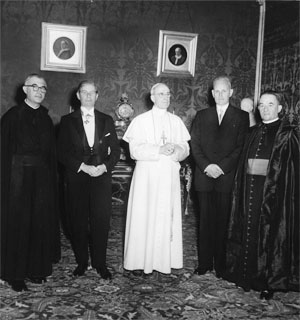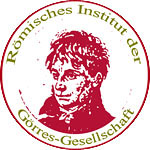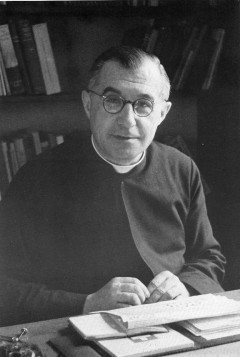Engelbert Kirschbaum SJ (1949-1959)
The Jesuit Engelbert Kirschbaum, born in Cologne in 1902, worked as an art historian and archaeologist in Rome and on Roman themes from 1932. His work contributed significantly to the reconstruction of the RIGG after the Second World War. He resigned from his post as director of the Görres Institute at the end of 1959 in order to devote himself entirely to the encyclopaedia of Christian iconography which he had conceived and edited.
After attending the Kaiser Wilhelms-Gymnasium in Cologne (Abitur: 08.02.1921) he entered the Jesuit Order on 11.04.1921 in 's Heerenberg (Güeldres), studied philosophy from 1923-1926 at the Philosophical-Theological Teaching Institute of the Society of Jesus of the Ignatius College in Valkenburg. He then studied art history and archaeology in Munich. His teachers were Rudolf Kömstedt and above all Wilhelm Pinder. On 21.12.1928, he was awarded a doctorate by the Faculty of Philosophy with the thesis "Die deutsche Nachgotik. A contribution to the history of Christian architecture from 1550 to 1800". This was followed by theological studies in Valkenburg from 1928 to 1932, where he was ordained priest on 27 August 1931.
From 1932 to 1934 he studied at the Pontificio Istituto di Archeologia Cristiana, where he was especially mentored by his Cologne countryman Leo Kunibert Mohlberg O.S.B.. The licensed thesis was on the spatial character of the early Christian basilica. The topic of the doctoral thesis was initially planned to be the reliquary translations, then he switched to the evangelist symbols, finally - Wilhelm Neuss had preceded him with the evangelist symbols - to Aether. Importanza e figurazione de l'Aeter nella poesia e nell'arte della prima età cristiana; with this work he became - "alla scuola di mons. Wilpert" (A. Ferrua) - on 30.06.1934.
After his tertianship in Münster from 1934 to 1935, Kirschbaum was spiritual director of the philosophy students at the Philosophical-Theological College of St. Georgen (Frankfurt). In March-April 1935 he visited northern Spain and met Pedro Batlle y Huguet (Tarragona) and Eduard Junyent i Subirà (Vic). From 1936 to 1939 he was a scriptor and second editor at the "Stimmen der Zeit" in Munich. In 1936-1937 Kirschbaum worked in consultation with Mohlberg on a collection of excerpts from the Liber Pontificalis on the history of architecture. Since 1929 he had always given lectures on art history and Christian archaeology, both in Valkenburg and at the Philosophical-Theological College Sankt Georgen in Frankfurt, where he had been professor of art history since 27.07.1929 (he lectured here until 1940, then only in 1953), and at the Johannes Berchmans College in Pullach. From Munich he was appointed to the Gregorian University in 1939 to teach art history at the Faculty of Church History. In fact, he read the entire history of art there in 1940 until his death, whereas at the Faculty of Theology he first taught Theologiae monumentorum (1941-1943).
 His students included Corrado Leonardi and Jerzy Langman. Because of the difficult circumstances at the Pontificio Istituto di Archeologia Cristiana (via Napoleone III, 1) after the death of Johann Peter Kirsch, he was released by his superiors from 1941-1947 to take over the chair of Edifici di Culto u. Arredamento liturgico; he was succeeded in this post by Bruno Maria Apollonj Ghetti in 1948. In 1941-1942 Kirschbaum also read iconography on behalf of Lucien de Bruyne. His work at the Pontificio Istituto di Archeologia Cristiana resulted in the booklet Catacombe romane. From the autumn of 1947, Kirschbaum read Christian Archaeology and Christian Epigraphy at the Gregorian Faculty of Church History in addition to Art History: he took over the lecture Archaeologiae et Epigraphiae Christianae from Romano Fausti S.J. (until 1961; successor Louis Martínez-Fazio S.J.). After Fausti's death, he also took over his art history seminar at the Faculty of Theology from 1951 (until 1963). Furthermore, he held the special course Sepulchrum SS. Apostolorum Petri et Pauli and later sporadically other special courses on art history. Finally, in 1962-1963, he took over Christian Archaeology from Ludwig von Hertling S.J., which now appears again as an independent introductory lecture within the Faculty of Theology (successor to Martínez-Fazio S.J.). Since 30.11.1950 he was a corresponding member, since 26.01.1956 an effective member of the Pontificio Accademia Romana di Archeologia. 1945-1956 he lectured several times at the "Conferences for Christian Archaeology". Kirschbaum led a group that met monthly at the Priscilla Catacomb; its members included Hermine Speier, Martha Wegan, Elisabetta Lucchesi-Palli and Kurt Körbel. Kirschbaum, who was in close personal contact with Ludwig Kaas, was involved in the deliberations on the excavations in St. Peter's from the time of his arrival in Rome. Together with Antonio Ferrua S.J., Enrico Josi and Bruno Maria Apollonj-Ghetti, he played a decisive role in the excavations from 1940-1949 (especially 1941-1942), and it was here that "son étonnante mémoire visuelle, ses qualités et ses dons d'observation et de critique" (V. Saxer) became apparent. He was not involved in the supplementary excavations 1953-1957. He intervened in the discussions about the tomb of St. Peter and the relics of St. Peter with a sober view (confirmation of the tomb of St. Peter, scepticism about the relics of St. Peter), while Ferrua and M. Guarducci were fiercely at loggerheads. His monograph "The Tombs of the Princes of the Apostles" goes in many ways beyond what is offered by the Esplorazioni.
His students included Corrado Leonardi and Jerzy Langman. Because of the difficult circumstances at the Pontificio Istituto di Archeologia Cristiana (via Napoleone III, 1) after the death of Johann Peter Kirsch, he was released by his superiors from 1941-1947 to take over the chair of Edifici di Culto u. Arredamento liturgico; he was succeeded in this post by Bruno Maria Apollonj Ghetti in 1948. In 1941-1942 Kirschbaum also read iconography on behalf of Lucien de Bruyne. His work at the Pontificio Istituto di Archeologia Cristiana resulted in the booklet Catacombe romane. From the autumn of 1947, Kirschbaum read Christian Archaeology and Christian Epigraphy at the Gregorian Faculty of Church History in addition to Art History: he took over the lecture Archaeologiae et Epigraphiae Christianae from Romano Fausti S.J. (until 1961; successor Louis Martínez-Fazio S.J.). After Fausti's death, he also took over his art history seminar at the Faculty of Theology from 1951 (until 1963). Furthermore, he held the special course Sepulchrum SS. Apostolorum Petri et Pauli and later sporadically other special courses on art history. Finally, in 1962-1963, he took over Christian Archaeology from Ludwig von Hertling S.J., which now appears again as an independent introductory lecture within the Faculty of Theology (successor to Martínez-Fazio S.J.). Since 30.11.1950 he was a corresponding member, since 26.01.1956 an effective member of the Pontificio Accademia Romana di Archeologia. 1945-1956 he lectured several times at the "Conferences for Christian Archaeology". Kirschbaum led a group that met monthly at the Priscilla Catacomb; its members included Hermine Speier, Martha Wegan, Elisabetta Lucchesi-Palli and Kurt Körbel. Kirschbaum, who was in close personal contact with Ludwig Kaas, was involved in the deliberations on the excavations in St. Peter's from the time of his arrival in Rome. Together with Antonio Ferrua S.J., Enrico Josi and Bruno Maria Apollonj-Ghetti, he played a decisive role in the excavations from 1940-1949 (especially 1941-1942), and it was here that "son étonnante mémoire visuelle, ses qualités et ses dons d'observation et de critique" (V. Saxer) became apparent. He was not involved in the supplementary excavations 1953-1957. He intervened in the discussions about the tomb of St. Peter and the relics of St. Peter with a sober view (confirmation of the tomb of St. Peter, scepticism about the relics of St. Peter), while Ferrua and M. Guarducci were fiercely at loggerheads. His monograph "The Tombs of the Princes of the Apostles" goes in many ways beyond what is offered by the Esplorazioni.
In 1950, Kirschbaum was consulted by Angelo Renato Pantoni O.S.B. for excavations in the monastery church of Montecassino (Benedict and Scholastic tombs) and under the cathedral of Santiago de Compostela. From 26.11.1949, he succeeded Hermann Maria Stoeckle as director of the Roman Institute of the Görres Society. Under him, the Institute was admitted in 1949 to the Unione Internazionale degli Istituti di Archeologia, Storia e Storia dell'Arte in Roma, which had been entrusted on an interim basis with the trusteeship of the confiscated German scientific institutes in Rome. If the German institutes for archaeology, history and art history were not internationalised, as the victorious powers envisaged, but returned to German hands, this was also thanks to Kirschbaum.
From 1954, he co-edited the Roman Quarterly, which was based at the Campo Santo Teutonico, and was responsible for the Christian archaeological section until his death. However, he resigned from his post as director of the Görres Institute at the end of 1959 in order to devote himself entirely to the encyclopaedia of Christian iconography which he had inaugurated and edited. Iconography, which met his iconographic interests. He lived to see the publication of the first volume. His successor as director of the Görres Institute was Voelkl. From 1959, Kirschbaum helped him and August Schuchert to run the study courses for teachers of religion at the Campo Santo Teutonico. Kirschbaum travelled to Ephesus and southern India and researched the apostle tombs believed to be there. "Had he remained in Germany, he would probably soon have taken a leading position in questions of ecclesiastical art. In Rome he succeeded only in part. It is true that he not infrequently played an active part in the building of churches and in their artistic decoration, but other, sometimes curious, artistic concepts of authoritative personalities barred him from advancing to key positions. It mattered all the less to him that he was pushed more and more into the archaeological field" (F. Kempf). Ferrua, who died at the age of over a hundred, wrote in his obituary of Kirschbaum, who knew no enemies due to his Rhenish cheerfulness, that he had started many beautiful things and never finished them; however, it was his cancer that took Kirschbaum away all too soon.
His grave is on the Campo Santo Teutonico.
- Details
- Category: Former Directors
 Römisches Institut der Görres-Gesellschaft
Römisches Institut der Görres-Gesellschaft







